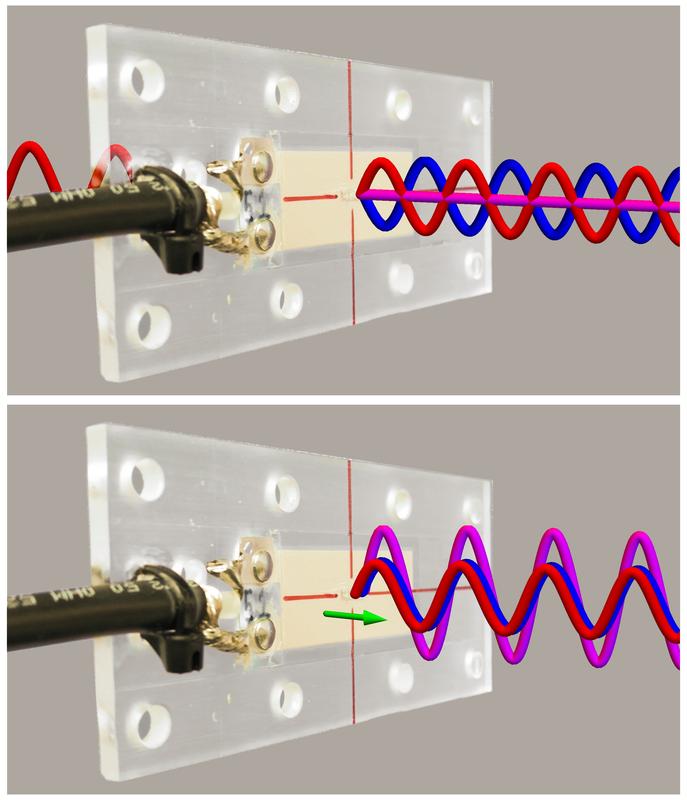

Before motion (top) the light scattered by the target (blue) extinguishes the excitation (red). After the motion (bottom), the scattered light is displaced and the waves enhance each other (magenta).
MPI für Kernphysik
A team of theoretical physicists from the MPI for Nuclear Physics (MPIK) in Heidelberg has developed a novel method to intensify the spectrally broad x-ray pulses of state-of-the-art x-ray sources in a narrow spectral region. Such x-ray pulses are desired for a number of fundamental physics experiments or are a prerequisite for some precision experiments.
The key roles are played by a piezoelectric transducer which performs precise motions upon electric signals and by a thin iron foil. Precisely synchronized motions redistribute the photons within the x-ray pulse to a narrow wavelength region. “Together with a team from the division of Thomas Pfeifer at the MPIK, the Deutsche Elektronen-Synchrotron (DESY) in Hamburg and the European Synchrotron Radiation Facility (ESRF) in Grenoble, we could demonstrate that the method works.
In fact, the spectrum of x-ray pulses can be manipulated by purely mechanical means”, says Jörg Evers from the division of Christoph Keitel at MPIK and emphasizes the advantages: “Our method doesn’t waste photons like a monochromator that only cuts off the undesired wavelengths. On the other hand, we don’t need to increase the overall energy of the x-ray pulse.”
For their experiments, the physicists used x-ray pulses of the synchrotron facilities ESRF and PETRA III (DESY). The method is based on the Mössbauer effect; therefore, the iron foil is enriched with the isotope 57Fe. In the solid state, this “Mössbauer isotope” may absorb and emit photons without recoil. Thus, the iron foil absorbs an extremely small section of the relatively broad x-ray pulse and “resonantly” emits this light after a certain time delay.
Within this short time span, the piezoelectric transducer moves the iron foil such that the resonant wavelengths are enhanced at the expenses of the “outer” wavelengths due to interference effects. “This displacement by half the resonant wavelength must be controlled to less than a tenth of a nanometer and take place within a few nanoseconds”, explains first author Kilian Heeg, PostDoc in the group of Jörg Evers, the requirements.
In the future, the new method could be advanced for deployment in the routine operation of x-ray sources like synchrotrons or free-electron lasers. The increased intensity results in shorter measurement times and enables measurements with presently low signal rates. Further, the higher signal rates translate into better energy, temporal and spatial resolution. On the other hand, the technique opens the possibility to track motions on atomic scales.
Original publication:
Spectral narrowing of x-ray pulses for precision spectroscopy with nuclear resonances K. P. Heeg, A. Kaldun, C. Strohm, P. Reiser, C. Ott, R. Subramanian, D. Lentrodt, J. Haber, H.-C. Wille, S. Goerttler, R. Rüffer, C. H. Keitel, R. Röhlsberger, T. Pfeifer, J. Evers
Science 357, 375-378 (2017) doi: 10.1126/science.aan3512 http://science.sciencemag.org/content/357/6349/375
Contact:
PD Dr. Jörg Evers
Division Keitel, MPI für Kernphysik
Tel.: +49 6221-516-177
E-Mail: joerg.evers(at)mpi-hd.mpg.de
Prof. Dr. Thomas Pfeifer
MPI für Kernphysik
Tel.: +49 6221-516-380
E-Mail: thomas.pfeifer(at)mpi-hd.mpg.de
Prof. Dr. Ralf Röhlsberger
Deutsches Elektronen-Synchrotron DESY
Tel: +49 40 8998 4503
email: ralf.roehlsberger(at)desy.de
https://www.mpi-hd.mpg.de/keitel/evers/ -Group Evers (MPIK, Division Keitel)
https://www.mpi-hd.mpg.de/mpi/de/pfeifer/pfeifer-division-home/ – Division Pfeifer (MPIK)
http://photon-science.desy.de/research/research_teams/magnetism_and_coherent_phe… – Group Röhlsberger (DESY)















